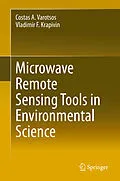This book gives new insight to the study of the global environmental changes using the ecoinformatics and microwave remote sensing tools together with the adaptive-evolutionary technology of geoinformation monitoring. The main advantage of this book consists in the accumulation of the interdisciplinary scientific knowledge for the parameterization of the global biogeochemical cycles and other environmental processes in the context of globalization and sustainable development. In this regard, the crucial global problems of the dynamics of the climate-nature-society system have been considered and the key problems of ensuring its sustainable development have been addressed. An analysis of the present trend in changing ecological systems has been discussed, including different types of forest ecosystems and ocean aquatories. The emphasis has been given to the accomplishment of the global geoinformation monitoring, which could provide a reliable control of the environmental processes development with reliable prognostic estimates of the consequences of human activities. A new approach to the numerical modelling of the climate-nature-society system has been presented and demonstrative results have been given about the modelling of the dynamics of this system s characteristics, in cases of realization of some scenarios of the anthropogenic impacts to the biogeochemical cycles, the land ecosystems and oceans. Methods and algorithms for the big data manipulation and processing in the remote sensing environmental monitoring systems have been described.
Autorentext
Costas Varotsos is Professor of Atmospheric Physics and former Dean of the School of Science of the National and Kapodistrian University of Athens, Greece. His main research interests include remote sensing, climate dynamics, atmospheric physics & chemistry, environmental change, and non-linear processes. He has published more than 300 research papers in peer reviewed journals, 18 monographs and has contributed chapters to a further six books. He has coordinated or participated in more than 50 large international research competitive projects, funded by National, European and International Organizations (e.g. European Commission, ESA). He has been Editor-in-Chief, Editor and Associate Editor of several international journals with peer-review system. Since January 2020, he is Editor-in-Chief of the Remote Sensing Letters (T&F). He has received the gold A.S. Popov medal from the Russian A.S. Popov Society, the RADI Award from the Chinese Academy of Sciences, and the MOST/ESA Award. He has been awarded with the title of Honorary Professor from several Universities and Institutes.
Vladimir F. Krapivin was educated at the Moscow State University as mathematician in 1959. He received his PhD in radiophysics from the Kotelnikov Institute of Radioengineering and Electronics (KIRE) of Russian Academy of Sciences (RAS) in 1966. The Doctoral Dissertation in geophysics was defended him at the Moscow Institute of Oceanology of RAS in 1973. He became Full Professor of Radiophysics in 1987. The title Honoured Worker of Science was given to him in 1999 by Russian Government. He was appointed Grand Professor in 2012 at the Nguyen Tat Thanh University (Vietnam). Vladimir Krapivin is a full member of the Russian Academy of Natural Sciences. He has published 37 books and 570 papers in the field of ecoinformatics, remote-sensing and global modeling. At present time he is chief scientists of KIRE and he has specialized in investigating global environmental change by the application of modeling technology and remote sensing tools.
Inhalt
Contents
1 Basic Concepts of Microwave Radiometry
1.1 Introduction
1.2 Principal Concept of Remote Monitoring Technology
1.3 Microwave Emission from the Water and Land Surfaces
1.3.1 Brightness Temperature
1.3.2 Dielectric Constant
1.3.3 Emissivity Coefficient1.3.4 Microwave Radiation Sensitivity to Variations of Basic Environmental Parameters
1.4 Remote-Sensing Research Platforms and their Equipping
1.5 Microwave Polarization Characteristics of Snow
1.5.1 Introduction
1.5.2 Theoretical and Empirical Tools for Studying the Microwave Irradiation of the Snow Layer
1.5.3 Experimental measurements
1.5.4 Analysis and Discussion of Empirical Results2 Remote Sensing Technologies and Data Processing Algorithms
2.1 Microwave Methods
2.2 Physical, Theoretical and Experimental Background of Microwave Monitoring
2.3 Remote Sensing Technologies in Infrared and Optical Bands
2.4 The atmosphere Microwave Monitoring
2.5 Algorithms for Remote Data Processing
2.5.1 Data Reconstruction Using the Harmonic Functions
2.5.2 Method for Parametric Identification of Environmental Objects
2.5.3 Method of Differential Approximation
2.5.4 Quasi-linearization Method
2.6 Interpretation Technology for Remote Sensing Data
2.7 Multi-Channel Microwave Sensor to Measure Environmental Parameters
2.8 Direct and Inverse Problems of Microwave Monitoring
2.9 Interferometry Methods in the Geo-risk Assessment Tasks
3 Constructive Method of Vegetation Microwave Monitoring
3.1 The Information-Modeling Technology
3.2 Microwave Monitoring of Soil-Plant Formations
3.3 Links between Experiments, Algorithms, and Models
3.4 Microwave model of vegetation cover
3.4.1 Two-Level Model of Vegetation Cover
3.4.2 Analytical Model of Vegetation Cover
3.5 Microwave Radiation of the Soil-Plant Systems
4 Microwave Remote Sensing of Soil Moisture
4.1 Uncertainty and Risk Sources in Remote Sensing
4.2 Practical Microwave Radiometric Risk Assessment of Agricultural Function
4.3 Geoinformation Monitoring System of Agricultural Function
4.4 Microwave Monitoring of Soil Moisture
4.5 The State of Soils and Water Objects Evaluated by Means of Radiometry Methods
5 Vegetation Screening Effect in the Remote Sensing Monitoring
5.1 Introduction
5.2 Attenuation of Electromagnetic Waves in Vegetation Media
5.3 Measuring System for Retrieving Attenuation of Microwaves in the Vegetation.
5.4 Experimental Results
5.5 Theoretical Generalization
5.6 Conclusions and Discussion
6 Microwave Tools for the Diagnostics of Forest Fires
6.1 Wildfire Causes
6.2 Wildfires and Global Ecodynamics
6.2.1 Fires and Forest Ecosystems
6.2.2 Wildfires, Dynamics of the Biosphere, and Climate
6.2.3 Biomass Burning and Atmospheric Chemistry
6.2.4 Wildfires and Carbon Cycle6.3 Microwave Radiometric Observations of Temperature Anomalies
6.4. Features of Microwave Monitoring of Wildfires
6.4.1 Microwave Model of the Wildfires
6.4.2 Fire Forest Risks
6.4.3 SHF-Radiation of the Forest Fires
6.4.4 Natural SHF-Radiation of the Peat Formations
7. Space Methods and Monitoring Tools for the Investigation of Aquatic Systems.
7.1 Introduction
7.2 Microwave Radiometry in the Remote Monitoring of the Ocean
7.3 Application of Big Data Approach to the Study of Arctic Basin Pollution
7.3.1. Introduction
7.3.2 Geoecological Information-Modeling System
7.3.3 Modeling the Pollutant Dynamics in the Arctic Basin
7.3.4 Simulation Experiments
7.3.5 Conclusions and Discussion
7.4 Implication of Geoecological Information-Modeling System ...
